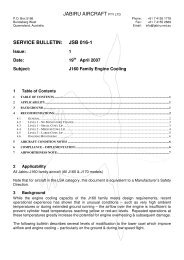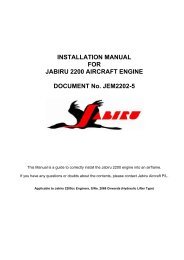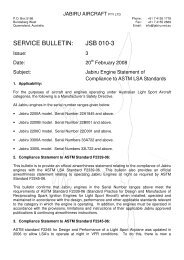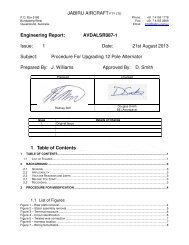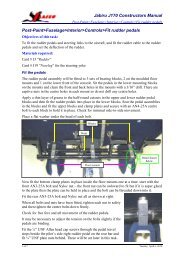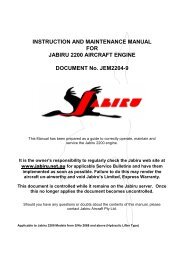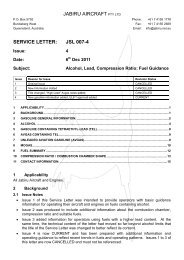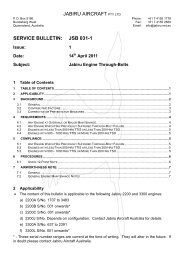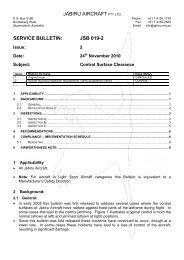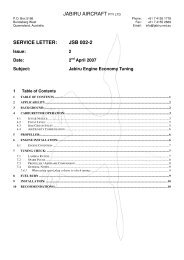Propeller Technical Manual - Jabiru
Propeller Technical Manual - Jabiru
Propeller Technical Manual - Jabiru
You also want an ePaper? Increase the reach of your titles
YUMPU automatically turns print PDFs into web optimized ePapers that Google loves.
<strong>Propeller</strong> <strong>Technical</strong> <strong>Manual</strong><br />
JPM0001-1<br />
<strong>Jabiru</strong> Aircraft Pty Ltd<br />
4A482U0D And 4A484E0D <strong>Propeller</strong>s<br />
3.5 Abnormal Operations:<br />
3.5.1 Running In Rain<br />
<strong>Jabiru</strong> Aircraft do not recommend or endorse operating in rain.<br />
The following is intended as a guide for owners who have, for whatever reason, been forced to fly through<br />
rain.<br />
- Do not operate in heavy rain or hail.<br />
- Know your limitations and the limitations of your aircraft. If in doubt, divert or land.<br />
- Maintain situational awareness – do not fly into rising terrain or near high obstacles (radio towers etc)<br />
in low visibility conditions.<br />
- If forced to fly through rain reduce engine RPM. 2600rpm or less is recommended – though the pilot<br />
must maintain a safe airspeed.<br />
- Monitor propeller condition – on landing check the blades for damage. Minor damage can be repaired<br />
in the field in accordance with the details given in Section 5.6.2. Do not fly on with damage beyond<br />
the limits set in Section 5.6.2.<br />
- A Urethane leading edge is provided for impact protection and also allows the propeller to be run in<br />
rain if required. However, the propeller is not intended for extended operation in heavy rain. Running<br />
in heavy rain will erode the Urethane in time – reducing the efficiency of the propeller blade and<br />
upsetting its balance.<br />
- After extended running in rain the Urethane may become so badly worn that the composite leading<br />
edge underneath is exposed. Once exposed, the fibreglass will quickly be damaged by continued<br />
operation in rain. It is possible that a propeller which has been damaged to this extent may suffer<br />
fibreglass de-lamination from a blade – massively reducing propeller efficiency and increasing<br />
vibration to the point where the engine must be shut down. This makes continued operation with<br />
exposed fibreglass edges extremely hazardous.<br />
This document is controlled while it remains on the <strong>Jabiru</strong> server. Once this no longer applies the document becomes uncontrolled.<br />
ISSUE 1 Dated : 1st Feb 2013 Issued By: DPS Page: 15 of 32<br />
L:\files\<strong>Manual</strong>s_For_Products\<strong>Propeller</strong>_<strong>Manual</strong>s\JPM0001-1_Prop_<strong>Manual</strong> (1).doc





